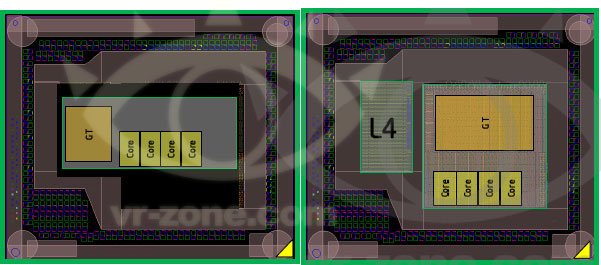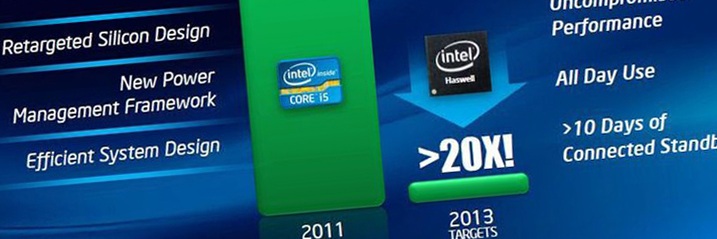Haswell will be the central topic at Intel Developer Forum next month, but already more details have surfaced. This time we are looking at packaging configurations that details the number of cores, graphics and memory channels for Haswell in all its hapes and sizes.
Haswell will be released next year and focus on energy efficiency and better graphics. With a total of three graphics configurations and two or four processor cores, Intel has to make sure they are mass produced in the right configurations to fit with OEM and retail needs. CPU World has now detailed seven different circuit configurations that will be made by Intel.
| Market | Cores | Graphics | Memory channels (modules per channel) | Packaging | RAM (up to) |
| Desktop | 4 | GT2 | 2 (2) | LGA | 32 GB |
| Desktop | 2 | GT2 | 2 (2) | LGA | 32 GB |
| Mobile (Performance) | 4 | GT3 | 2 (2) | BGA | 32 GB |
| Mobile (Mainstream) | 4 | GT2 | 2 (2) | BGA / rPGA | 32 GB |
| Mobile (Mainstream) | 2 | GT2 | 2 (1) | BGA / rPGA | 16 GB |
| Mobile (Ultrabook) | 2 | GT3 | 2 (1) | BGA | 16 GB |
| Mobile (Ultrabook) | 2 | GT2 | 1 (1) | BGA | 8 GB |
For desktops there will be two versions, with two or four cores. Both will have dual memory channels with support for up to four memory modules and the graphics will be GT2-based. It is likely there will be desktop Haswell processors with GT1 too, but if this is correct they will have a cut down GT2 instead. They are packaged as LGA just like Ivy Bridge processorer, which means the pins are on the motherboard and the processor can be replaced by the end user.
The mobile processors come in several different variaties. The performance chip gets four cores, two memory channels, supports two modules each, and the more powerful GT3 graphics Intel has to offer. It is likely that this is the 57 W TDP processors we reported on a while back, which Intel hopes will replace the majority of dedicated graphics cards in notebooks. It is also this one that will get the rumored L4 cache. The top model that this is, is only available as BGA (Ball Grid Array), which means it is soldered to the board.

For the mainstream ther will be a chip with four cores, GT2 graphics and dual memory channels, but 2 modules per channel. There is also a lower-end version with two cores, GT2 graphics and dual memory channels, but only 1 module per channel supported. The quad-core version comes in 37 and 47 W suits, but the dual-core we expect to land at 37 watt. These processors comes in BGA packaing, but also rPGA, which means the pins are on the porcessor and in theory could be upgraded by the end user.
Finally we have the ultrabooks chips with TDPs at only 15 W. The top configuration will get two processor cores and dual memory channels, one module per channel, but there is GT3 graphics. The cheaper version will be crippled with two cores, GT2 graphics and a single memory channel. We know that the chips for ultrabooks will also get an integrated southbridge. There is most likely no L4 cache to be found, due to the tight power budget. They only come in BGA packaging and will not be upgradeable.
It might be tough to keep track of Intel’s coming processor architecture, but it sure looks like Intel has tried to cover almost all needs?





😀 😆 🙂 😉 8) 😐 :-* 😳 🙁 😥 😮 😕 😡 😮 :zzz 😛 🙄 :sigh: